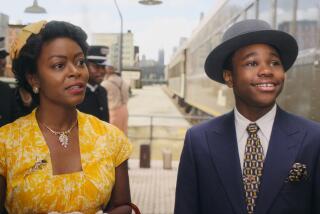MOVIE REVIEWS : Good, Evil Clash in ‘Serpent and Rainbow’
- Share via
Wes Craven’s “The Serpent and the Rainbow” (citywide) does for the old Caribbean zombie movie what Steven Spielberg’s “Raiders of the Lost Ark” did for the serials. It preserves all the spooky fun of a movie like “White Zombie” while drawing upon all the sophisticated resources of big-budget modern film making: richly photographed authentic locales, wondrous special effects and amazingly acute sound recording.
Actually, “Serpent” is riskier than “Raiders” because instead of being a period piece, it is set in Haiti just as Jean-Claude Duvalier is being driven into exile. The result is an ambitious, entertaining--though not flawless--feat of the imagination, a highly visual and skillful blending of supernatural and political terror, high adventure and anthropology.
The brink-of-revolution Haiti in which Harvard anthropologist Dennis Alan (Bill Pullman) arrives has all the tumult, vitality, poverty and danger of the opening sequences of London on the edge of chaos in “Sammy and Rosie Get Laid.”
What Alan, who is in quest of trance powder for medical research, quickly learns from dedicated psychiatrist Marielle Celine (Cathy Tyson, the beautiful call girl of “Mona Lisa”) is that within the voodoo blend with Christianity, there is a rejection of the duality of good and evil--represented, respectively, by the rainbow and the serpent.
Celine may have no conflict with her scientific training and her religious beliefs, but in Haiti, clearly evil has the upper hand. Indeed, the key proposition of “The Serpent and the Rainbow,” which was inspired by anthropologist Wade Davis’ book of the same title, is that the implacably sinister Peytraud (Zakes Mokae), a leader of the feared Ton-Ton Macoutes, actually defuses political protesters by turning them into zombies.
Craven, the cult horror picture director in a major career advance, and his writers Richard Maxwell and A. R. Simoun, project and sustain an aura of suspense, action and romance sufficient to persuade us to go along with this notion.
Where their audacious and highly sensual mix of the documentary, the supernatural and classic Hollywood adventure tale doesn’t quite jell is that adventure traditionally calls for a larger-than-life hero. Alongside clear respect for Haitian culture and the country’s awesome political and economic problems, Alan emerges as an old-fashioned white liberator. He may be of normal build, but he can dispatch a trio of large and muscular Ton-Ton Macoutes with a couple of karate chops. Indeed, Alan’s emergence as a kind of great white savior is lots queasier in effect than the film’s deliberate scare tactics.
“The Serpent and the Rainbow” works anyway, but it would have worked better had the hero been played by a black actor. Luckily, Pullman, in his first starring role after key appearances in “Ruthless People” and “Spaceballs,” has an amiable, natural presence.
Tyson is lovely in a typical leading lady role, and Paul Winfield draws on his strong presence to fill in his one-dimensional good guy part as a nightclub operator who’s also a voodoo priest. Mokae, the distinguished South African actor, is a thoroughly terrifying villain whose glare is as chilling as his torture devices. Brent Jennings has much humor as a clever and brave con man. John Lindley’s cinematography, Brad Fiedel’s ethnic-flavored score--which includes special percussion tracks by eminent drummer Babatunde Olatunji--and Jay Boekelheide’s eerie and acute sound design are all superb.
As Duvalier’s plane takes off at the end of “The Serpent and the Rainbow” (rated R for sex, violence and nudity), Marielle exclaims that for Haiti, “the nightmare is over.” If only that had proved true.
More to Read
Only good movies
Get the Indie Focus newsletter, Mark Olsen's weekly guide to the world of cinema.
You may occasionally receive promotional content from the Los Angeles Times.









